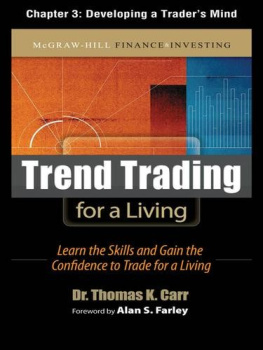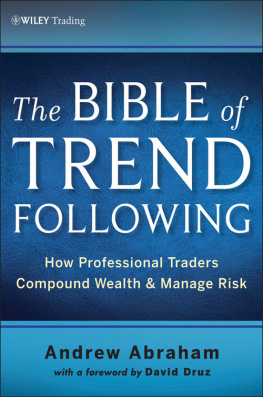T HE T REND F OLLOWING B IBLE
Founded in 1807, John Wiley & Sons is the oldest independent publishing company in the United States. With offices in North America, Europe, Australia, and Asia, Wiley is globally committed to developing and marketing print and electronic products and services for our customers professional and personal knowledge and understanding.
The Wiley Trading series features books by traders who have survived the markets ever-changing temperament and have prosperedsome by reinventing systems, others by getting back to basics. Whether you are a novice trader, a professional, or somewhere in between, these books will provide the advice and strategies needed to prosper today and well into the future.
For a list of available titles, visit our Web site at www.WileyFinance.com .
T HE T REND
F OLLOWING
B IBLE
How Professional Traders Compound
Wealth and Manage Risk
Andrew Abraham

Cover image: Andrew Liefer
Cover design: Danin Tulic/iStockphoto
Copyright 2013 by Andrew Abraham, Inc. All rights reserved.
Published by John Wiley & Sons, Inc., Hoboken, New Jersey.
Published simultaneously in Canada.
No part of this publication may be reproduced, stored in a retrieval system, or transmitted in any form or by any means, electronic, mechanical, photocopying, recording, scanning, or otherwise, except as permitted under Section 107 or 108 of the 1976 United States Copyright Act, without either the prior written permission of the Publisher, or authorization through payment of the appropriate per-copy fee to the Copyright Clearance Center, Inc., 222 Rosewood Drive, Danvers, MA 01923, (978) 750-8400, fax (978) 646-8600, or on the Web at www.copyright.com . Requests to the Publisher for permission should be addressed to the Permissions Department, John Wiley & Sons, Inc., 111 River Street, Hoboken, NJ 07030, (201) 748-6011, fax (201) 748-6008, or online at http://www.wiley.com/go/permissions .
Limit of Liability/Disclaimer of Warranty: While the publisher and author have used their best efforts in preparing this book, they make no representations or warranties with respect to the accuracy or completeness of the contents of this book and specifically disclaim any implied warranties of merchantability or fitness for a particular purpose. No warranty may be created or extended by sales representatives or written sales materials. The advice and strategies contained herein may not be suitable for your situation. You should consult with a professional where appropriate. Neither the publisher nor author shall be liable for any loss of profit or any other commercial damages, including but not limited to special, incidental, consequential, or other damages.
For general information on our other products and services or for technical support, please contact our Customer Care Department within the United States at (800) 762-2974, outside the United States at (317) 572-3993 or fax (317) 572-4002.
Wiley publishes in a variety of print and electronic formats and by print-on-demand. Some material included with standard print versions of this book may not be included in e-books or in print-on-demand. If this book refers to media such as a CD or DVD that is not included in the version you purchased, you may download this material at http://booksupport.wiley.com . For more information about Wiley products, visit www.wiley.com .
Library of Congress Cataloging-in-Publication Data
Abraham, Andrew.
The trend following bible : how professional traders compound wealth and manage risk / Andrew Abraham.
pages cm. (Wiley trading series)
Includes index.
ISBN 978-1-118-40774-5 (cloth); ISBN 978-1-118-42186-4 (ebk),
ISBN 978-1-118-43439-0 (ebk), ISBN 978-1-118-41763-8 (ebk)
1. Investment analysis. 2. Portfolio management. 3. Investments. 4. Risk management. I. Title.
HG4529.A27 2013
332.645dc230
2012043888
To my Family, Ruthie, Gabrielle, Ariel, Micael, my mother, and all those who supported me along my journey of trend following, thank you.
FOREWORD
I 've been trading for investors for over 30 years. My first fund, Tactical Commodity Fund, started in mid-1981. Tactical's current program began in 1993 as an offshoot of that first fund but with lower leverage and some evolutionary changes. I've learned a lot over the years. I've seen a lot of markets, a lot of bull moves, a lot of bear moves. And I can tell you I wish I had read this book 30 years ago. I would have made more money, especially near the beginning. Do yourself a favor. Read it. Now.
My trading-for-investors career began not long after gold peaked around 870 and a bit over a year before the S&P bottomed near 100. I subsequently watched gold drop more than 70 percent over 19 years and then rally over 700 percent in the next 12. I watched the stock market rally for over 17 years with just one big, brief pullback along the way only to witness two retracements greater than 50 percent in the next 10 years.
I've seen almost too numerous to remember booms and busts in the commodity, currency, and interest rate markets. I've seen things happen that everyone said never would and watched as things didn't happen that everyone said were inevitable. I've traded and held positions in these markets nearly every single day since mid-1981.
Tactical was one of the first systematic, computerized fund managers. We started out on a Radio Shack TRS 80, before the first Apple. Historical data that costs pennies now took months to type in by hand. We ran Fourier transforms and proved there were in fact no repeatable hidden cycles in the markets while everyone else was still talking about them. We tested all the market lore to see what was true and what wasn't. We tested the early mechanical systems that were touted and found most of them didn't hold up. Indicators that people still use today we learned years ago don't really give you a statistical advantage.
I wrote my own back-testing software and tested everything I could think of. When personal computers advanced we bought the latest. For a number of years we had two Sun workstations running 24/7 doing systems testing when those were state of the art. Of course, now you can do the same things much faster on a laptop. But that was then and this is now. We kept testing. We kept learning.
I read every book I could get my hands on about trading. I listened to the old traders. When I worked during summer breaks in college at a brokerage firm at the Chicago Board of Trade I kept my ears open as the old-timers related their adventures, their successes, their failures. I tried to understand the psychology of the winners and how it differed from that of the losers. I got the idea that the psychology of the trader was as important if not more important than anything in success or failure.
I spent a lot of time learning things the hard way, a lot of trial and error, a lot of hard knocks. Trading is still a lot of hard knocks. Drawdowns can go on seemingly forever. You can have days, weeks, even months on end without much in the way of profits. It can feel as if you are a punching bag or a movie double who takes all the hits. But that's the nature of the game, of the business.
Even after you've learned how to do it, you still take your hits. To succeed, you just need to stand up every time you get knocked down. You need to have the confidence that standing up is the right thing to do. You need to know when to stand back up and how. And just by standing up again and again and staying standing as long as you can before you get hit again, well, you can actually make more money than you lose over the long run in trend trading. It's quite an amazing process.















